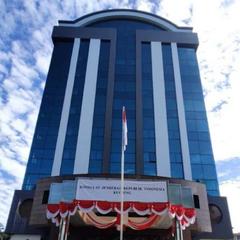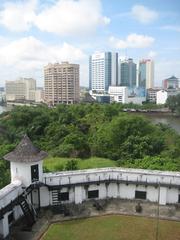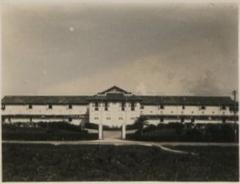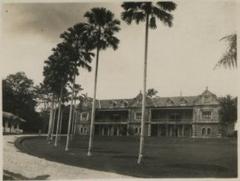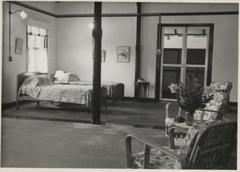Chinese History Museum Kuching: Visiting Hours, Tickets, and Complete Guide
Date: 15/06/2025
Introduction
The Chinese History Museum Kuching, set against the picturesque Kuching Waterfront in Sarawak, Malaysia, offers an immersive journey into the heritage and cultural legacy of the region’s Chinese community. Occupying the historic Old Chinese Court building from 1912, the museum chronicles the migration, settlement, and integration of Chinese groups such as Hokkien, Cantonese, Hakka, Teochew, and Foochow into Sarawak’s social and economic tapestry. Through well-curated artifacts, photographs, and multimedia displays, the museum illustrates the pivotal role of Chinese Malaysians in shaping Sarawak’s multicultural identity. This comprehensive guide covers the museum’s history, exhibitions, visiting hours, ticket details, accessibility, special events, travel tips, and nearby attractions.
For further information, visitors are encouraged to consult trusted resources like Malaysia Traveller, Lonely Planet, and the Sarawak Museum Department.
Table of Contents
- History and Cultural Significance
- Thematic Exhibitions and Collections
- Visiting Hours and Ticket Information
- Accessibility and Visitor Facilities
- Special Events and Guided Tours
- Travel Tips for Visitors
- Nearby Attractions
- Frequently Asked Questions (FAQ)
- Plan Your Visit and Call to Action
- References
History and Cultural Significance
Origins: The Old Chinese Court
Constructed in 1912, the Old Chinese Court was originally a judicial center serving Kuching’s Chinese community until 1921. It played a crucial role in resolving civil disputes among various dialect groups and symbolized the community’s organized structure during the colonial era. The building’s colonial architecture—with its symmetrical façade and arched windows—reflects its historical and architectural significance.
Transition to the Chinese General Chamber of Commerce
After its role as a courthouse, the building became the headquarters of the Sarawak Chinese General Chamber of Commerce in 1930, facilitating economic coordination and strengthening the Chinese community’s influence in regional trade.
Restoration and Museum Establishment
In 1993, recognizing the building’s historic value, local authorities restored it and opened it as the Chinese History Museum. The museum’s mission is to educate the public about the Chinese migration to Sarawak and their enduring impact on local culture and economy, preserving both the architectural heritage and the collective memory of Sarawak’s Chinese community.
Thematic Exhibitions and Collections
The museum’s compact yet rich displays are organized around several interwoven themes:
Historical Artifacts and Memorabilia
Standout exhibits include Qing Dynasty ivory statues of an emperor and empress, Ming Dynasty ceramics, jade treasures, and musical instruments. These objects reflect both the artistry and daily life of early Chinese settlers (Malaysia Traveller).
Photographic and Documentary Displays
Archival photographs and bilingual information panels (English and Malay) trace the migration paths, settlement patterns, and history of nine major Chinese communities in Sarawak, including Hakka, Cantonese, Teochew, Hokkien, Chao Ann, and Henghua. Panels cover the three major waves of immigration and the establishment of clan associations (Lonely Planet).
Cultural Costumes and Festival Artifacts
Vibrant dragon and lion dance costumes, ceremonial wear, and festival regalia demonstrate the enduring importance of festivals and communal celebrations in maintaining cultural identity.
Trade and Daily Life Exhibits
Displays include an original rickshaw, agricultural and mining tools, market scenes, and documentation of traditional trades such as gold and antimony mining, reflecting the community’s economic contributions (Malaysia Traveller).
Profiles of Prominent Figures
Biographical displays highlight the achievements of key Chinese leaders and dignitaries, featuring personal memorabilia, official documents, and photographs (Malaysia Traveller).
Visiting Hours and Ticket Information
Opening Hours
- Monday to Friday: 9:00 AM – 4:45 PM
- Weekends & Public Holidays: 10:00 AM – 4:00 PM
- Closed: Occasionally for maintenance or special events—check ahead on the official Sarawak Museum website.
Admission Fees
-
Entry: Free of charge, in keeping with the Sarawak Museum Department’s policy (Sarawak Museum Department).
-
Group Tours: Can be arranged upon request, especially for educational or special interest groups.
Accessibility and Visitor Facilities
- Location: Jalan Bazar, Kuching Waterfront—central and within walking distance of major hotels and attractions (GoWhere Malaysia).
- Mobility: The single-story museum is generally accessible; ramps and accessible restrooms are provided, though some heritage features may require caution. Wheelchair users may wish to contact the museum in advance for specific arrangements.
- Signage: All exhibits labeled in English and Malay.
- Amenities: On-site restrooms, photography permitted (flash may be restricted), and a mini-theater screening an introductory documentary (Siti Mustiani).
- Reception: Friendly staff are available to answer queries or provide informal guidance.
Special Events and Guided Tours
- Events: The museum occasionally hosts cultural festivals, temporary exhibitions, and community workshops, especially during major Chinese celebrations.
- Guided Tours: Not regularly scheduled but can be arranged in advance; staff are willing to offer insights and answer questions.
Travel Tips for Visitors
- Best Time to Visit: Morning hours on weekdays for a quieter experience.
- Photography: Allowed in most areas; flash and tripods may be restricted.
- Family Visits: Interactive exhibits such as the classroom replica and Family Name Wall are popular with children.
- Combine Visits: Plan to visit the Tua Pek Kong Temple, Main Bazaar, and Kuching Waterfront for a comprehensive cultural tour.
- Weather: The museum offers a comfortable indoor activity during Kuching’s rainy spells.
Nearby Attractions
- Tua Pek Kong Temple: Kuching’s oldest Chinese temple, just across the street.
- Main Bazaar & Carpenter Street: Lined with heritage shophouses, crafts, and local eateries.
- Kuching Waterfront: A scenic promenade ideal for walking, photography, and dining.
- Old Courthouse & Textile Museum: Other nearby heritage sites for deeper exploration (The Crazy Tourist).
Frequently Asked Questions (FAQ)
Q: What are the Chinese History Museum Kuching visiting hours?
A: Monday–Friday, 9:00 AM–4:45 PM; weekends and public holidays, 10:00 AM–4:00 PM.
Q: Is there an admission fee?
A: Entry is free for all visitors.
Q: Is the museum wheelchair accessible?
A: Mostly accessible; contact the museum in advance for specific needs.
Q: Are guided tours available?
A: While regular tours are not scheduled, staff are available to provide information and answer questions.
Q: Can I take photographs?
A: Yes, but flash and tripods may be restricted.
Q: How do I get there?
A: The museum is located on the Kuching Waterfront, easily reachable by foot, bus, or ride-hailing services.
Q: What other attractions are nearby?
A: Main Bazaar, Tua Pek Kong Temple, Old Courthouse, Kuching Waterfront, and Textile Museum.
Plan Your Visit and Call to Action
Ready to uncover Sarawak’s Chinese heritage? Explore the Chinese History Museum Kuching for an enriching cultural experience. Make the most of your visit by downloading the Audiala app for guided tours, insider tips, and up-to-date event information. For more on Kuching’s historical sites, visit our Kuching Travel Guide and follow us on social media.
References
- Chinese History Museum Kuching: Visiting Hours, Tickets, and Historical Insights, Malaysia Traveller
- Visiting the Chinese History Museum Kuching: Hours, Tickets, Exhibits, and Cultural Insights, Lonely Planet
- A Complete Visitor’s Guide to the Chinese History Museum Kuching: Hours, Tickets, and Must-Know Tips, Siti Mustiani
- Sarawak Museum Department Official Website
- GoWhere Malaysia: Chinese History Museum
- The Crazy Tourist: Best Things to Do in Kuching
